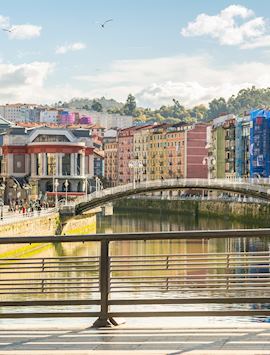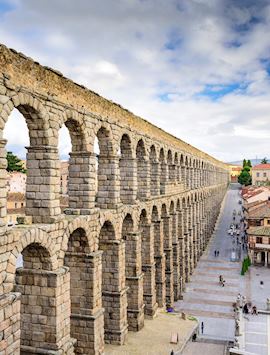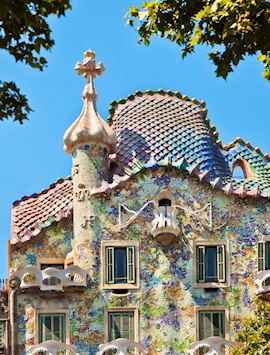From cities celebrated by the art world to whitewashed villages surrounded by quiet vineyards, our specialists’ favorite places to visit in Spain span an array of regions, each culturally and historically distinct from the other. In the north, Barcelona and Bilbao are playgrounds of modern architectural marvels, while Andalusia’s cityscapes and cultures have been shaped by Muslim, Jewish, and Christian communities alike.
Wherever you choose to visit, we’ll pair you with local guides who can show you the country through their eyes. You might step into a cave dwelling in Grenada’s Roma district to watch a flamenco show unfold or spend an afternoon dining with a private gastronomic society in Spain’s culinary center, San Sebastián. Along the coast, you can take private sunset cruises or enjoy a little rest and relaxation on sun-gilded sands.
Our specialists will mix and match Spain’s best places to visit to create a trip that speaks to your passions.
Choose your destination
1. Barcelona

Why visit: medieval streets, modernist art & golden beaches
Catalonia’s cultural capital, Barcelona has been a canvas and muse for Spain’s most celebrated artists and architects. Antoni Gaudí’s swirling Sagrada Família rises from the city, Pablo Picasso’s works hang in his namesake museum, and locally born Joan Miró’s art is on display in nearby Montjuïc.
We can pair you with a private guide who’ll help you delve into Barcelona’s cultural heritage on a walking or cycling tour of the city. Or you could choose to focus your day entirely on Gaudí’s influence as you visit Casa Milà, Park Güell, and the not-quite-finished Sagrada Família with a local expert.
Away from the well-known highlights, you can soak up Barcelona’s electric atmosphere on a tapas tour that leads you to family-run shops, or take to the water on a private sailing experience along the Mediterranean coast at sunset.
We can also arrange for you to see the fingerlike formations of nearby Montserrat that point up to the heavens in front of the mountainside monastery of the same name.
Dig deeper: Barcelona boasts some of the best paella in the country, and you can learn the secrets behind this saffron-infused rice dish during a private cooking class and market visit with a local chef.
Don’t miss: With an eclectic mix of mosaics, stained glass, and embellished ceilings, Palau de la Música Catalana is a masterpiece of modernist Catalan architecture. We can arrange for you to enjoy a musical performance under its vaulted roof.
- Get me there: Barcelona & the Costa Brava
2. Madrid
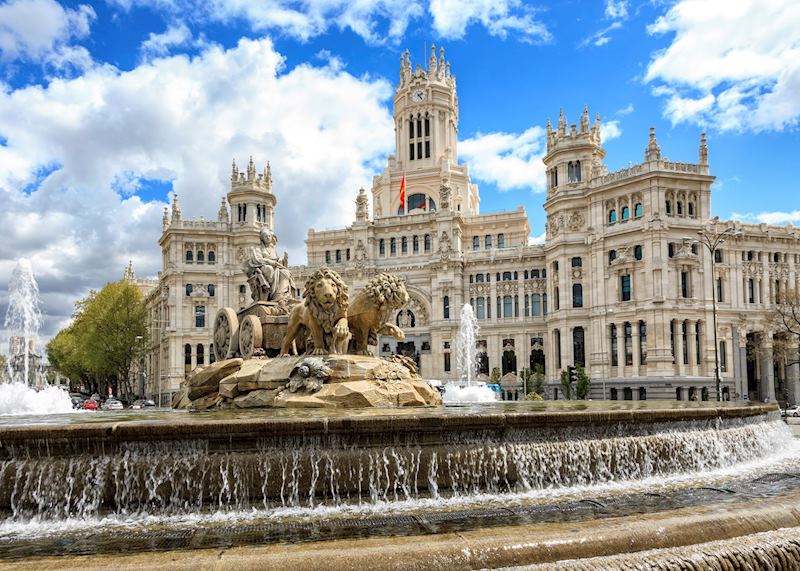
Why visit: sweeping plazas, world-class museums & delectable dishes
Originally a fort city built by the Moors, Madrid is now a sprawling metropolis that reflects the many layers of Spain’s history. You can peer up at baroque buildings, gaze at Belle Époque palaces, sip coffee on sun-soaked plazas, and admire carefully curated exhibits in one of the city’s many museums.
See the highlights on a walking tour that takes you to the wide-open Plaza Mayor, lively Puerta del Sol, and Museo del Prado, which showcases the Spanish monarchy’s collection of artworks. If you’d like to linger longer in the museums, we can arrange for you to spend half a day with a local art expert at both Museo del Prado and Museo Reina Sofía, so you can contrast the 16th- and 17th-century works with modern masterpieces, like Picasso’s Guernica.
For a taste of Spain, you could join a private cooking class, where you’ll learn how to prepare classic tapas dishes like tortilla de patatas (potato omelette), chorizo a la sidra (chorizo in cider), gambas al ajillo (garlic shrimp), and patatas bravas (fried potatoes in a spicy tomato sauce).
Dig deeper: Venture just outside of the capital and you’ll find fields striped with grapevines. For a different perspective on the region, you can visit a family-run winery to get a behind-the-scenes look at local wine production, followed by a tasting overlooking the vineyards.
Don’t miss: Teatro Flamenco Madrid is the world’s first flamenco theater, attracting a leading cast of artists. We can book tickets (VIP, if you like) for an evening performance of song, dance, and plenty of passion.
- Get me there: Highlights of Madrid, Barcelona & Mallorca
3. Seville
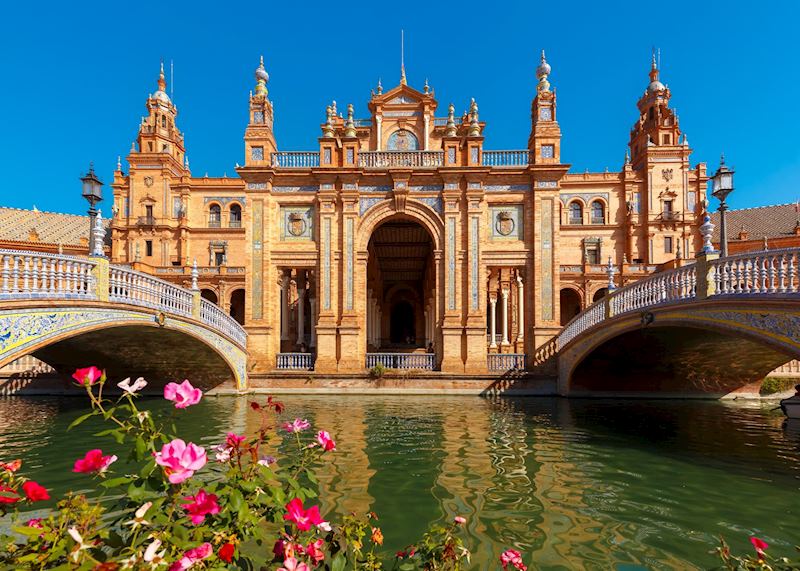
Why visit: medieval streets, modernist art & golden beaches
Square minarets and ornate tiled walls give you a glimpse into Seville’s past as a Moorish city. But Islamic influences aren’t the only defining characteristic of the Andalusian capital — there’s the old Jewish quarter with its limewashed buildings and narrow streets, a Venetian-inspired canal in the Plaza de España, and the sleek modern Metropol Parasol that gives you a chance to walk high above the city.
You can explore Seville’s highlights by carriage, bike, or on foot with a private guide, who’ll share stories about its history, culture, and the communities who’ve lived here over the centuries. We’ll also arrange tickets for you to visit Seville’s cathedral and the Real Alcázar at your own leisure. Both are leading examples of how Moorish architecture and Christian influences have melded over the years.
Seville is also a great springboard for exploring the surrounding towns and countryside. You could visit a family-run olive mill to learn how boutique olive oil is made, or go hiking in Jabugo, where black pigs feast on acorns — the key to providing the finest jamón ibérico.
Dig deeper: Combine two of Spain’s cultural greats — tapas and flamenco — during a guided tour, which starts at the city’s very best culinary haunts and ends with a performance of the city’s home-grown artform at an authentic venue.
Don’t miss: Outside of Seville, you could visit the Royal Andalusian School of Equestrian Art for a performance at these internationally renowned stables. We’ll arrange for you to sit in the VIP area to watch how the horses skillfully dance to music, before meeting the riders during the intermission.
- Get me there: Southern Spain explored
4. Granada
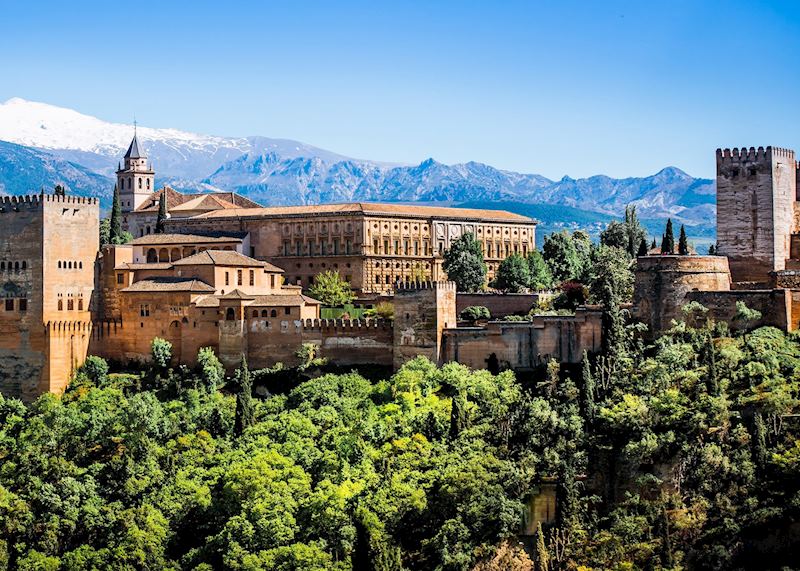
Why visit: Alhambra Palace, Arab influences & cave dwellings
Another of Andalusia’s great Moorish cities, Granada is best known for its mountain-backed Alhambra Palace, often dubbed the finest example of Islamic architecture in Europe. Moorish influences are found right across the city, with its Arab bathhouses, winding medina-like streets, and sprinkling of converted mosques.
Alhambra is one of the most visited sites in all of Spain, so we recommend going with a private guide. They’ll help steer you away from the crowds and take you to quieter corners. As you tour, you’ll learn about the Nasrid emirs who lived here in the 14th century and the Spanish royals who later called it home following the Reconquista.
During your time in Grenada, you could also take a private cooking class, where you’ll prepare and feast on Spanish and Andalusian delicacies like salmorejo (a creamy soup similar to gazpacho), tortilla de patatas, and paella, washed down with a heady glass of sangria.
Dig deeper: Just above the main city, Sacromonte is home to a Roma community who live in whitewashed hillside caves. You can spend an evening inside one of the caves, where local artists will sing and dance flamenco, upholding a centuries-old tradition.
Don’t miss: The towns of Úbeda and Baeza are around a 90-minute drive from Granada, but well worth a visit for their UNESCO-protected Renaissance architecture. You’ll go with a private driver and guide, who’ll recount the history of the region as you stroll past carved stone buildings dating back to the 16th and 17th centuries.
- Get me there: Southern Spain explored
5. San Sebastián
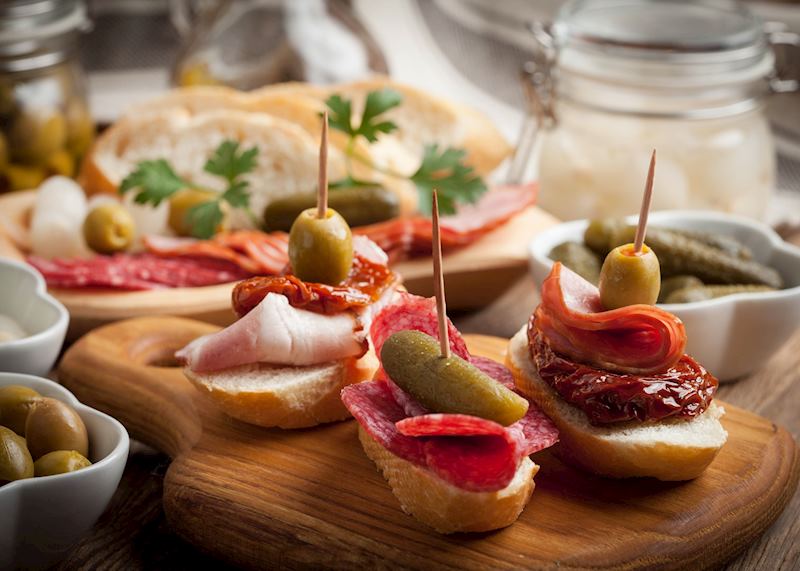
Why visit: wining, dining & hiking
San Sebastián lies on the golden Bay of Biscay in the mountainous Basque Country and was once a beachside playground for 19th-century royalty. This gave rise to a culinary culture unmatched in the rest of the country, making it one of Spain’s best places for food lovers. There are ten Michelin-starred restaurants in this compact city alone, as well as dozens of tiny bars that serve pintxos (bite-size dishes held together with wooden skewers).
There are many ways you can delve into the city’s cuisine. You could join a local guide for a walking tour, where you’ll learn about the city’s history as you snack on an array of pintxos, from crunchy calamari to tuna ceviche and pickled peppers. Or, try your hand at making them yourself during a Basque cooking class.
Food might be the star of the show in the city but venture a little further out and forested hillsides beckon more active pursuits. We can pair you with a private guide who’ll take you to the best trails and viewpoints, including one overlooking the UNESCO-protected San Millán Monastery.
Dig deeper: Join an exclusive (but laidback) dining society for the day to celebrate the city’s finer cuisine, prepared by a food-fanatical group of locals. As you dine, you’ll also get to taste the society’s specially curated wines.
Don’t miss: Though wine is perhaps the most well-known tipple in the region (especially in nearby La Rioja), cider is equally as popular, and apple orchards dot the surrounding countryside. You can go on a private tour of a nearby cider farm, where you’ll visit the orchard, learn how cider is produced, and finish with a tasting.
- Get me there: Culinary highlights of Seville & San Sebastián
6. Bilbao

Why visit: the Guggenheim, pintxos & prehistoric caves
A city of contrasts, Bilbao brings together shiny avant-garde structures with more muted traditional streets. Home to the Guggenheim Bilbao, the Bilbao Fine Arts Museum, and an array of modern architectural feats, it’s a destination for design lovers.
To fully appreciate the twisting titanium form of the Guggenheim, architect Frank Gehry’s vision, and the contemporary art pieces that are displayed inside, we’ll arrange for you to visit with a local expert. Once you’ve explored its galleries, your guide will take you to central Bilbao, where you can stroll inside the Art Deco Mercado de la Ribera, a historic marketplace filled with local produce and cuisine.
Bilbao is another of the Basque Country’s gastronomy hubs, and you’ll find plenty of pintxos here, too. A local guide can help you find the best bars and bakeries on a tasting tour of nearby town Getxo.
Dig deeper: Much like San Sebastián, Bilbao boasts several members-only gastronomical societies, called txokos. We can help you become a member for the day as you join the culinary group for lunch in a small suburb by the sea.
Don’t miss: Take a break from ultra-modern design to visit the prehistoric Monte Castillo caves located 90 minutes east of Bilbao. As you descend into the caves, you’ll wander past stalactites, stalagmites, bright mineral deposits, and Palaeolithic art that dates back over 40,800 years.
- Get me there: Basque Country explorer
7. Mallorca
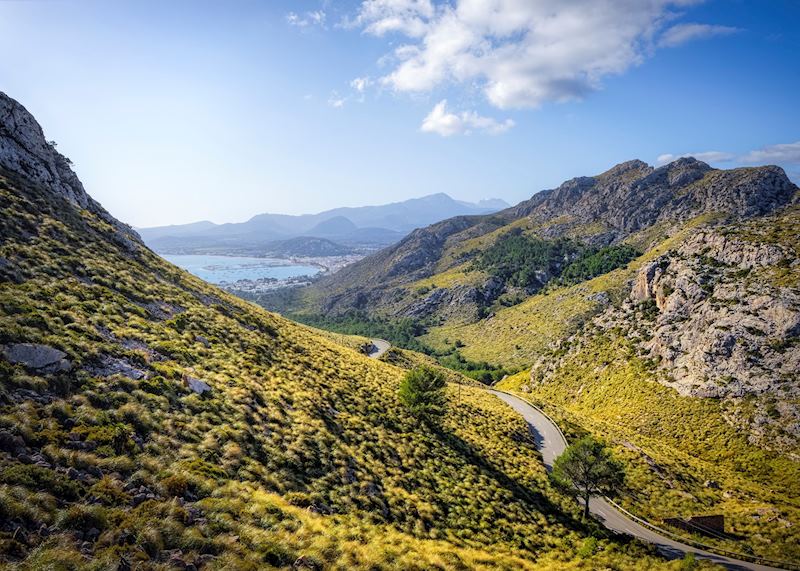
Why visit: crescent beaches, artisanal produce & outdoor adventures
The largest of the Balearic Islands, Mallorca isn’t just a feet-up beach destination (though we recommend spending some time on the sand, too). Head inland and you’ll find mountain trails flanked by farmland and a culture laden with artisanal traditions.
You might visit a 500-year-old estate to sample Son Moragues olive oil, learn how to prepare authentic paella with a chef, or go on a hike that leads to the verdant vineyard of a local wine producer. As you sample each delicacy, you’ll peel back the island’s layers that are easily missed on a beach-only retreat.
Though when it comes to basking in the warm waters of the Balearic Sea, we’ll help you find the most secluded seafront hotels and stretches of sand.
Dig deeper: Learn how to make sandals with a local shoemaker just north of Palma for an entirely personalized souvenir. Once you’re fitted for the correct size, you’ll choose your sandal design and leather, before getting to work.
Don’t miss: Beyond simply relaxing, the waters around Mallorca offer the chance for more adventure. Head out with a kayaking guide to explore the various caves that dot the coastline, stopping to swim and snorkel as you go.
- Get me there: Island hopping in the Balearics
8. Begur

Why visit: quiet beaches, sunset cruises & medieval streets
Nestled on the Mediterranean coast in Northern Catalonia, Begur offers a peaceful respite from the frenetic buzz of the region’s capital city, Barcelona. It can also act as a launchpad for exploring other medieval towns and villages in Costa Brava, like Girona and Pals.
When you’re not relaxing along the rock-sculpted coastline or scouting out the prettiest medieval buildings in and around the city, you can take a kayaking tour near the fortified fishing village of Tossa de Mar. As you paddle on the gentle waters, you can peer up at the sea cliffs and imposing city walls that frame the coastline.
In nearby Girona, you can take a private walking tour along the cobbled lanes to learn about its turbulent past — its medieval walls survived more than 20 sieges. Your guide will also steer you to the city’s Jewish quarter, where arms-width streets lead you to shaded courtyards.
Dig deeper: Just under an hour’s drive away is Figueres, the birthplace of Salvador Dalí. Together with your guide, you can visit the Dalí Theatre-Museum to admire his surrealist works, from reality-warped paintings to intricately designed jewelry.
Don’t miss: See Begur from the water on a private sunset cruise along the azure Mediterranean coast. Sip drinks and nibble on snacks as the sun paints the sky in a pink-orange glow.
- Get me there: Barcelona & the Costa Brava
9. Málaga & Marbella
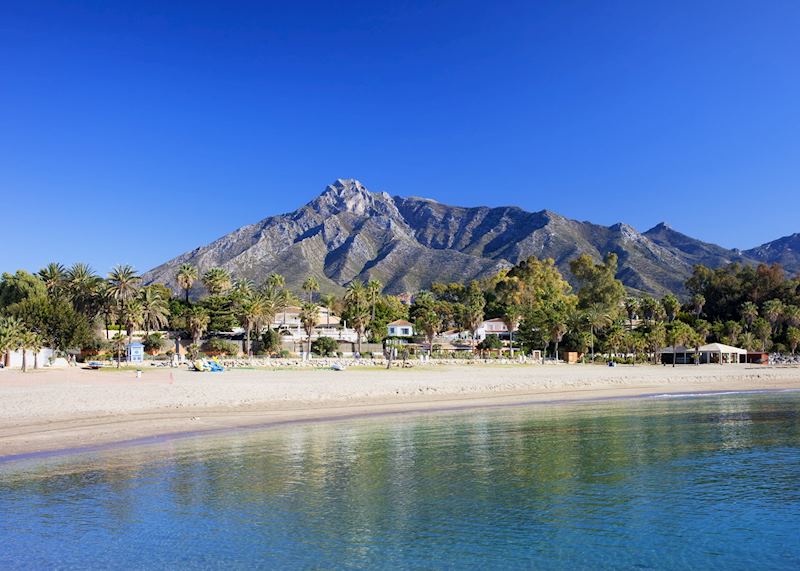
Why visit: whitewashed villages, glittering coast & art galleries
Often reserved for the end of a trip, both Málaga and Marbella on the Costa del Sol are some of Spain’s best places to unwind. With around 320 days of sunshine a year, beachside relaxation is a given, but we can also help you uncover the towns’ historical and cultural significance.
On a guided walking tour of Málaga, you’ll stroll around the city’s Gothic cathedral, Roman amphitheater, and the remains of Alcazaba, an 11th-century Moorish castle, before tucking into crispy churros con chocolate at the open market.
Both towns boast an array of galleries and museums to appease all types of art enthusiasts, including the Picasso Museum in Málaga, which houses over 200 of the artist’s works, and Marbella’s Museo Ralli, where you can ponder the works of Salvador Dalí, Joan Miró, Henry Moore, and Marc Chagall.
Dig deeper: Stretch your legs in between beach days with a gentle hike in the foothills of the Sierra Nevada mountains. As you walk, you’ll see sprinklings of whitewashed villages perched on the terraced hills.
Don’t miss: Within Andalusia’s gleaming white villages, you can delve into artisanal culture on a guided drive through the countryside. You might take a peek into leather workshops and taste regional delicacies like buñuelos, sweet dough fritters thought to have Moorish origins.
- Get me there: Southern Spain explored
10. Córdoba

Why visit: UNESCO World Heritage city, the Mezquita & tapas
Roman, Visigoth, Muslim, Christian, and Jewish communities have each contributed a historical and cultural layer to form Córdoba’s labyrinthine historic district. Once the capital of Spain and a European center of intellectualism, Córdoba is a UNESCO World Heritage Site, making it one of the top places to visit on a trip to southern Spain.
The city’s star landmark is the Mezquita, a sprawling former mosque that’s been altered over the years to become a cathedral. You can admire its echo-inducing high ceilings, red-and-white striped two-tiered arches, and ornate domed mihrab (prayer niche) on a guided tour of the city. You’ll also visit the winding streets of the former Jewish quarter, where your private guide will help you piece together the city’s complex story.
With plenty of fresh local ingredients, Córdoba is hailed for its quality cuisine. Garlicky chilled tomato soup, crispy fried eggplant laced with honey, and flaky sugar-topped pastries filled with sweetened squash jam are just some of the local delicacies you might try on a tapas tour tailored to your tastes.
Dig deeper: Discover what makes Córdoba’s food and drink so delicious by visiting a local olive oil mill set in a 19th-century Andalusian farmhouse, before tasting wine at a prestigious winery in nearby Montilla.
Don’t miss: Founded in 1570, the Royal Stables of Córdoba set out to breed only the finest Andalusian horses. Now, you can visit for a performance that brings together skilled horsemanship with the artistry of flamenco on the ground.
- Get me there: Southern Spain explored
Read more about trips to Spain
Start thinking about your experience. These itineraries are simply suggestions for how you could enjoy some of the same experiences as our specialists. They're just for inspiration, because your trip will be created around your particular tastes.
View All Tours in Spain
